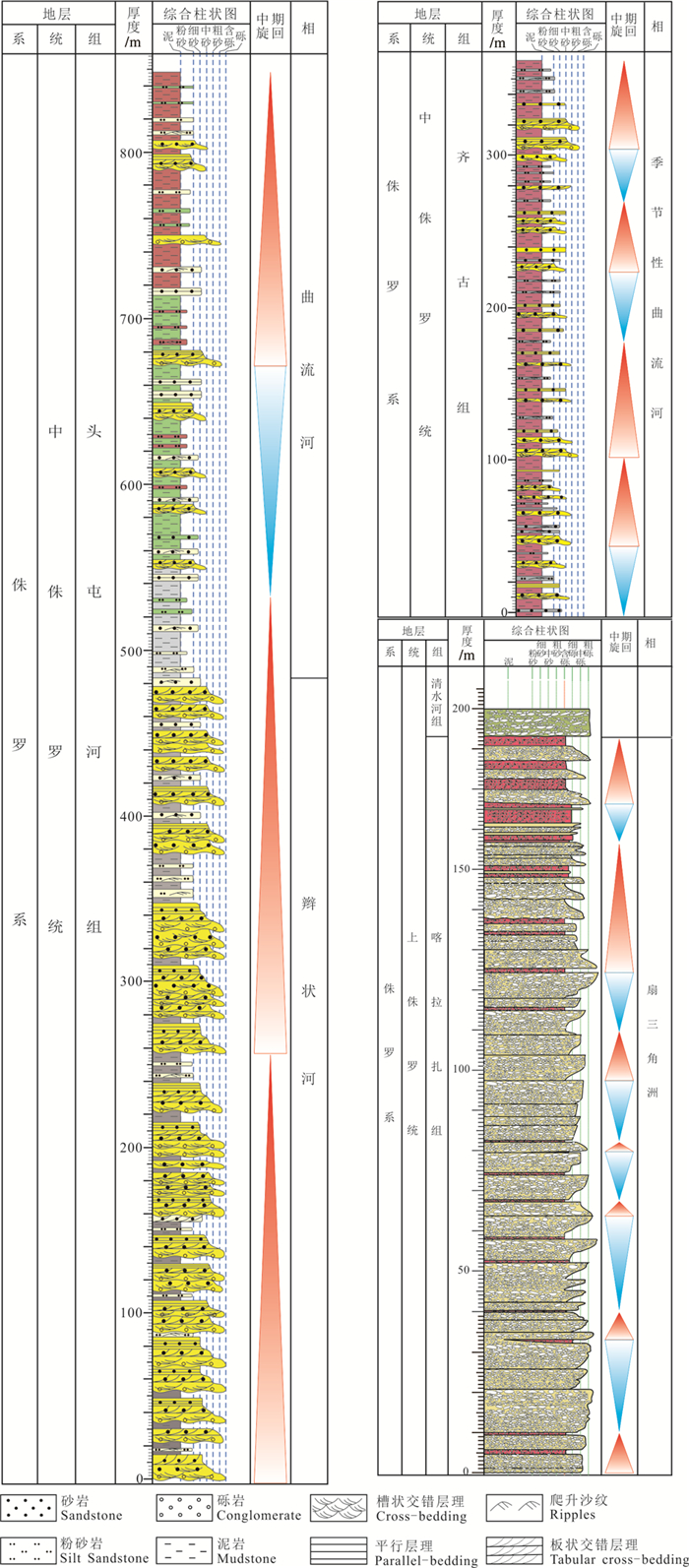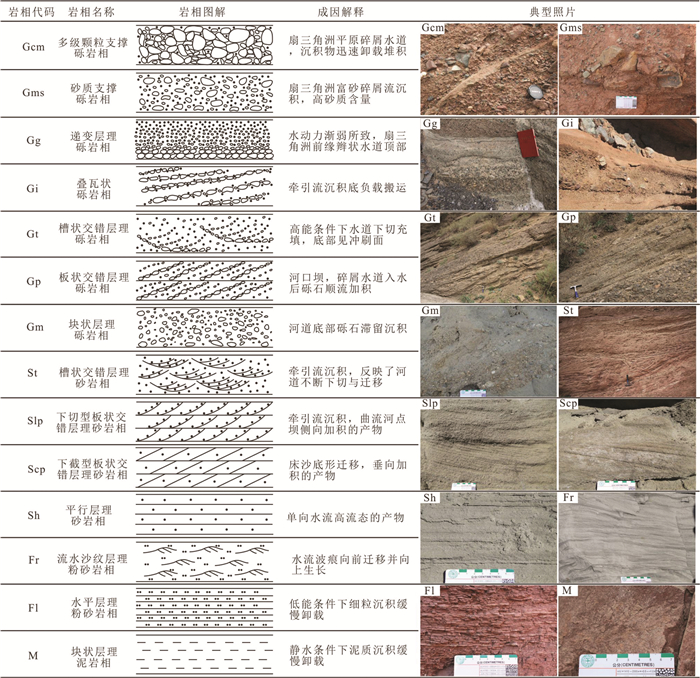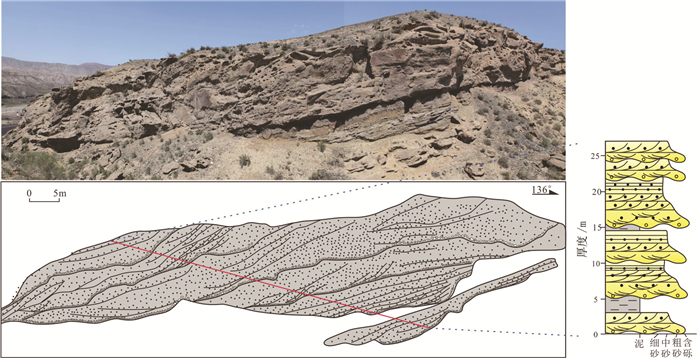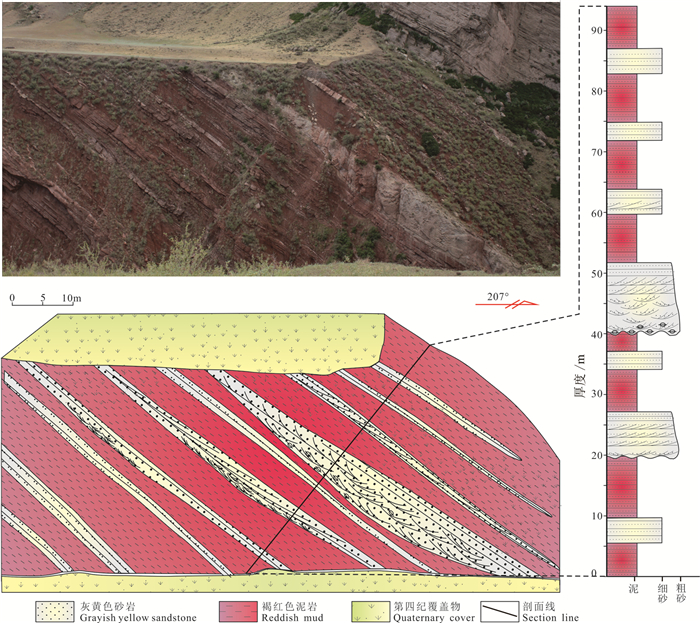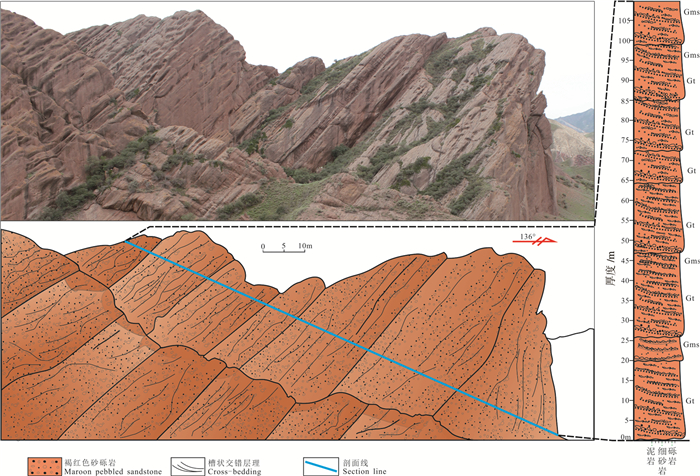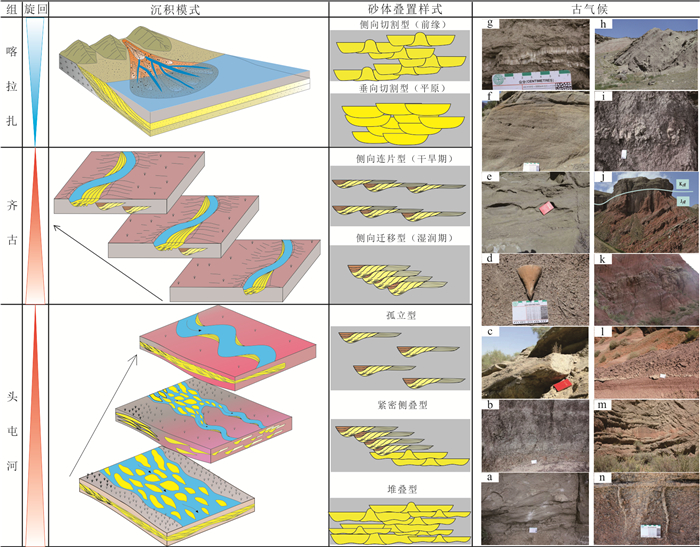Sedimentary evolution and controlling factors of the Middle-Upper Jurassic in the western part of the southern Junggar Basin
-
摘要:
针对准噶尔盆地南缘中、上侏罗统沉积体系演化控制因素不清、沉积模式不明等问题,通过对多条露头剖面精细解剖、详尽写实沉积特征描述等手段,分析了其垂向序列、砂体叠置方式、水动力条件、沉积体系演化及控制因素。研究表明准南中、上侏罗统自下而上分别发育辫状河沉积、曲流河沉积和扇三角洲沉积,古气候与构造造成的水动力条件的变化是控制这种沉积演化的主要因素。其中头屯河组底部发育辫状河沉积,古气候温暖湿润,形成堆叠型砂体叠置方式;中部发育辫-曲转换沉积,古气候开始初步干旱,形成紧密叠置型砂体;上部发育曲流河沉积,降雨量较少古气候干旱,形成孤立河道型砂体。齐古组发育季节性曲流河沉积,古气候较为干旱,在湿润期降雨量较充足时发育侧向迁移型砂体,干旱期则发育侧向连片型砂体。喀拉扎组发育扇三角洲沉积,古气候整体炎热干旱,构造活动剧烈,碎屑水道在扇三角洲平原构成垂向切割型砂体,而前缘水下分流河道则构成侧向切割型砂体。
Abstract:In order to solve the problems of the unclear sedimentary patterns and uncertain control factors of sedimentary evolution of the Middle-Upper Jurassic in the southern margin of the Junggar Basin, the vertical sequence, sand body superposition mode, hydrodynamic conditions, sedimentary system evolution and control factors were analyzed by means of fine dissection of several sections and detailed sedimentary description of outcrops in the field. The research shows that braided river sediments, river sediments and fan delta sediments of Middle-Upper Jurassic were deposited from bottom to top, and the changes in hydrodynamic conditions caused by paleoclimate and tectonic events are the main controlling factors of the sedimentary evolution. Specifically, at the bottom of the Toutunhe Formation, braided river sediments were deposited in a warm and humid paleoclimate, forming a stacking pattern of stacked sand bodies; in the middle, braided-meandering river sediments were deposited when the paleoclimate began to be initially arid, forming tightly superimposed sand bodies; and in its upper part, meandering river deposits were developed and isolated channel sand bodies were formed under the condition of less rainfall and paleoclimate drought. As to the Qigu Formation, seasonal meandering river sediments were deposited under arid paleoclimate conditions; the lateral migration sand bodies were developed when the rainfall was sufficient during the wetting period; and laterally continuous sand bodies were developed during the dry period. The Kalaza Formation fan-delta sediments were deposited under hot and dry paleoclimate and intense tectonic activities. The detrital channel formed a vertical cutting sand body in the delta plain, while its frontier underwater distributary channel formed a lateral cutting sand body.
-
1. 引言
侏罗系作为准噶尔盆地主力含油层系之一,早期研究多集中在中、下侏罗统八道湾组、三工河组和西山窑组的构造演化、沉积储层及成藏规律等相关方面(李维锋等,2001;何登发等,2007;谭程鹏等,2014;李胜利等,2015;厚刚福等,2017)。中侏罗统头屯河组以及上侏罗统齐古组在盆地南缘均可见良好的油气显示(季敏等,2009;德勒恰提等,2013),证实了中、上侏罗统的勘探潜力;上侏罗统喀拉扎组在南缘发育巨厚粗碎屑沉积(单新等,2014),在玛湖凹陷粗粒沉积取得突破性进展之后,也增加了其作为潜在目标层的可能性。陈彬滔等(2013)从露头沉积特征出发总结了南缘头屯河组岩相与岩相组合,认为南缘头屯河组中部发育曲流河沉积,并统计了曲流河侧积点坝的宽厚比,提出了曲流河成因砂体对比的方法;谭程鹏等(2014)以及李胜利等(2015)分别从露头和地下资料着手提出了南缘头屯河组辫-曲转换沉积模式,并认为基准面旋回是控制头屯河组曲流河向辫状河转换的关键因素;林潼等(2013)则认为南缘头屯河组以发育辫状河道为主,齐古组则主体发育辫状河-滨浅湖相;Yao et al.(2018)则认为南缘齐古组以发育曲流河沉积为主;单新(2014)等通过对准南水磨沟剖面喀拉扎组露头沉积特征的研究,认为该时期喀拉扎组发育冲积扇沉积。调研前人资料可知,对于南缘中、上侏罗统头屯河组、齐古组的沉积类型和沉积模式目前存在一定争议,而对于喀拉扎组的沉积特征以及沉积控制因素的相关研究较为缺乏。除此之外,前人更多的是对单一地层的探讨,而头屯河组至喀拉扎组在南缘连续沉积但沉积特征上差异明显,因此从整体角度对这3个地层组开展系统沉积特征研究有助于探讨南缘中、上侏罗统沉积演化以及造成沉积差异的控制因素。
在地震、钻井资料缺乏的情况下,野外露头作为准确、直观、具体的研究对象,对沉积特征、基准面旋回和砂体叠置样式的分析具有得天独厚的优势(赵俊峰等,2014;张驰等,2017)。受印度—欧亚板块碰撞的长期影响,侏罗系地层在准噶尔盆地南缘地表出露多条良好的连续露头剖面,从而吸引了大量学者。本文通过对野外露头沉积特征详细描述,利用包括地层颜色、岩性、粒度、沉积构造、生物化石等资料,识别岩相、分析水动力条件、建立垂向序列、解剖典型剖面,进而明确沉积环境,建立沉积模式,分析沉积体系演化及控制因素,以期为南缘中、上侏罗统的油气勘探提供一定的理论支撑与地质依据。
2. 地质概况
准噶尔盆地南缘主要指精河以东、木垒以西、乌伊公路以南、依林黑比尔尕山一带区域,在大地构造位置上属于哈萨克斯坦古板块的一部分,位于塔里木古板块、哈萨克斯坦古板块及西伯利亚古板块的交汇位置,三面被古生代缝合线包围(陈业全等,2004)。自晚石炭世始,该区域经历了3期较大的构造演化阶段:晚石炭世—早二叠世裂陷阶段、晚二叠世—古近纪拗陷阶段以及新近纪以后的类前陆阶段(陈书平等,2007;汪新伟等,2007;李本亮等,2010;方世虎等,2015;王家林等,2016;孙浩等,2020)。在新生代强烈构造作用以及北天山北麓诸多北向河流的切割下,形成了多条可供地质研究的优质野外露头剖面(图 1)。
![]() 图 1 准噶尔盆地南缘地层出露状况与考察路线(据方世虎, 2015, 修改)其中头屯河剖面起点43°45'23"N,87°13'45"E,终点43°43'26"N,87°12'35"E;呼图壁河剖面起点43°50'23"N,86°36'43"E,终点43°49'33"N,86°37' 06"E;红沟剖面起点43°55'15"N,85°52'04"E,终点43°56'11"N,85°51'42"EFigure 1. The Outcrops of the southern margin of Junggar Basin and the exploration route (modified from Fang et al., 2015)The Toutunhe profile start from 43°45'23"N, 87°13'45"E, end at 43°43'26"N, 87°12'35"E; The Hutubihe profile start from 43°50'23"N, 86°36'43"E, end at 43°49'33"N, 86°37'06"E; The Honggou profile start from 43°55'15"N, 85°52'04"E, end at 43°56'11"N, 85°51'42"E
图 1 准噶尔盆地南缘地层出露状况与考察路线(据方世虎, 2015, 修改)其中头屯河剖面起点43°45'23"N,87°13'45"E,终点43°43'26"N,87°12'35"E;呼图壁河剖面起点43°50'23"N,86°36'43"E,终点43°49'33"N,86°37' 06"E;红沟剖面起点43°55'15"N,85°52'04"E,终点43°56'11"N,85°51'42"EFigure 1. The Outcrops of the southern margin of Junggar Basin and the exploration route (modified from Fang et al., 2015)The Toutunhe profile start from 43°45'23"N, 87°13'45"E, end at 43°43'26"N, 87°12'35"E; The Hutubihe profile start from 43°50'23"N, 86°36'43"E, end at 43°49'33"N, 86°37'06"E; The Honggou profile start from 43°55'15"N, 85°52'04"E, end at 43°56'11"N, 85°51'42"E准噶尔盆地南缘侏罗系地层自下而上可划分为下侏罗统八道湾组(J1b)、三工河组(J1s);中侏罗统西山窑组(J2x)、头屯河组(J2t);上侏罗统齐古组(J3q)、喀拉扎组(J3k)(图 2)。准噶尔盆地由弱伸展拗陷向挤压性盆地的转变造成了西山窑组与头屯河组之间的不整合接触(白斌,2008)。中、上侏罗统头屯河组至喀拉扎组在南缘西段连续沉积,上下地层整合接触;喀拉扎组与上覆白垩系清水河组不整合接触。因此可将南缘头屯河组至喀拉扎组作为一个连续沉积的整体开展沉积特征、沉积模式演化等相关研究,分析在缺乏区域性构造运动下,造成连续沉积地层上下沉积特征差异的原因。本次研究选取了交通相对比较便利的头屯河剖面、呼图壁河剖面和红沟剖面进行实地测量。
3. 沉积特征与岩相解释
沉积特征与岩相解释是从沉积物岩相、颜色、粒度、沉积构造、砂体垂向变化方式等特征的精细描述着手,分析并解释岩相类型、垂向序列、砂泥互层规律、垂向叠置关系、水动力条件等,是判别沉积环境,建立沉积模式的关键所在(图 3)。
3.1 头屯河组
(1)沉积特征:头屯河组岩性主要为中层状泥岩与厚层状砂岩、含砾砂岩的韵律交互,夹炭质泥岩,偶见菱铁矿透镜体。下部以深灰色、灰色粗粒沉积为特征,交错层理规模大,纹层高角度斜交,多套砂体叠置切割;向上过渡为灰白色、灰绿色中细砂岩,夹棕红色条带,交错层理规模、岩石粒度、纹层斜交角度较下部砂体减小,宽厚比增大,具“二元结构”,表现出“泥包砂”的特征。单套砂体底部一般见冲刷面,并可见滞留砾石的定向排列,向上发育大型槽状交错层理、板状交错层理、平行层理、流水沙纹等牵引流成因沉积构造,垂向表现出正韵律,具典型的河流相沉积特征。
(2)岩相解释:头屯河组下部为辫状河沉积,宏观上表现出灰色厚层粗粒砂体夹薄层深灰色泥岩的“砂包泥”特征(图 4)。单期次水道呈顶平底凸的楔形,底部见冲刷面以及滞留砾石相(Gm);向上为强水动力条件下河道下切并迁移形成的槽状交错层理砾岩相(Gt)和槽状交错层理砂岩相(St);中部发育下切截型板状交错层理砂岩相(Scp),解释为垂向加积辫流坝;顶部为平行层理砂岩相(Sh),代表高流态下砂质沉积物的迅速沉积。典型垂向序列为Gm-Gt-St-Scp-Sh-M,为多期的辫状河道频繁迁徙与改道在侧向与垂向上不断切割叠置,河流水动力大而可容纳空间小,多形成于近源区。灰色砂岩、泥岩以及大量植物茎秆和硅化木化石证明,头屯河组沉积初期,发育于地形坡度较陡的斜坡上,整体古气候温暖湿润。
头屯河组上部为曲流河沉积,具典型的“二元结构”,单套砂体表现为单期次的曲流河道沉积特征,及平面上为宽缓的板状,底部为滞留沉积(Gm),向上过渡为河道下切充填形成的槽状交错层理砂岩相(St)、侧积成因的下切型板状交错层理砂岩相(Slp)、平行层理砂岩相(Sh)以及流水沙纹粉砂岩相(Fr),典型垂向序列为Gm-St-Slp-Sh-FrM与Gm-St-Fl-M,前者为曲流河河道和侧积点坝的典型组合,后者解释为废弃河道。上部曲流河中未见植物碎屑,且与下部辫状河沉积相比,砂体厚度与沉积构造规模减小,粒度以中细砂、粉砂为主,泥岩颜色亦从灰色过渡为灰绿色夹紫红色条带,体现了头屯河组沉积晚期,气候逐渐干旱,植被不发育,地形坡度减缓,水动力下降,可容纳空间增大,沉积物供给减少。
3.2 齐古组
(1)沉积特征:齐古组岩性以褐红色泥岩、粉砂质泥岩夹中—薄层灰黄色中细砂岩为主,呈“泥包砂”的特征,单套砂体底部可见泥砾,多为次圆状。发育槽状交错层理、板状交错层理、流水沙纹等牵引流成因沉积构造,平面上呈板状和透镜状,横向延伸远,宽厚比大,砂泥比低,未见植物化石(图 5)。
(2)岩相解释:齐古组为季节性曲流河沉积,沉积物粒度较细,砂岩以中、细砂为主,泥岩厚度较大,河道底部滞留砾石呈次棱角—次圆状,多具定向排列,说明沉积物经历了一定的搬运距离,距离物源较远,整体结构成熟度高于头屯河组。剖面上单砂体宽/厚比高,垂向上具典型的“二元结构”。曲流河道典型垂向序列为Gm-St-Slp-Sh-M-FrM,其中底部发育冲刷面,向上过渡为河道迁徙、充填形成的槽状交错层理以及侧向加积形成的低角度下切型板状交错层理,顶部发育平行层理以及流水沙纹,垂向上表现出明显的正韵律。由于齐古组沉积受气候控制明显,在湿润期,洪水携带沉积物漫过堤岸构成泛滥平原沉积,垂向序列为M-FrM,表现出厚层红色泥岩相(M)夹薄层流水沙纹粉砂岩相(Fr)的特征。当水动力较强时,洪水在凹岸冲破天然堤构成决口扇,底部见小型冲刷但缺乏滞留沉积,向上发育小型槽状交错层理和平行层理,顶部为厚层泥岩,垂向序列表现为St-Sh-M。
3.3 喀拉扎组
(1)沉积特征:喀拉扎组整体为厚层粗粒沉积,与底部齐古组褐红色泥岩突变接触。岩性主要为大套厚层状浅绿灰色、灰黄色细砾岩—中砾岩,夹中薄层褐红色砂砾岩和含砾泥岩,局部见透镜状中粗砂岩,垂向厚度大,横向延伸性很差。砾岩成分复杂,见石英岩碎屑、花岗岩碎屑等,砾石偶见定向排列,粒径通常为1~10 cm,个别砾石可达20 cm,分选较差,磨圆中等。受快速堆积的影响,沉积构造相对不发育,冲刷面通常不平整,其两端岩性突变,沉积有较大的砾石。在粒度较细的砂砾岩中可以见到小型槽状交错层理,一般为异心槽状交错层理,不同期次的槽状交错层理可被极薄层中粗砂分隔开,代表水动力条件的相对减弱,由砾质沉积转为砂质沉积。在中薄层褐红色砂砾岩或含砾泥岩中常发育有干裂构造,垂向上呈极窄的“V”字形,平面上则多为不规则多边形,其内部多充填有灰白色的中粗砂岩;干裂纹可贯穿于整套细粒岩层。在部分砾岩和含砾砂岩的中上部发育平行层理,纹层极薄,无明显的韵律变化。
(2)岩相解释:整个喀拉扎组地层粒度较粗,砾岩和砂砾岩占比重较大,而细粒沉积物相对较少,多发育多级颗粒支撑砾岩相(Gcm)、砂质支撑砾岩相(Gms)、递变层理砾岩相(Gg),偶见槽状交错层理砾岩相(Gt)、平行层理砂岩相(Sh)和板状交错层理砾岩相(Gp)等,单套砂砾岩层的厚度很大,其中部分砾石定向排列,这些都反映了较强的牵引流水动力条件。受迅速堆积的影响,砂砾岩中的沉积构造与韵律变化不明显,但中下部砂砾岩层多呈现出微弱的反粒序,上部的砂砾岩层多呈微弱的正粒序。砂砾岩层的顶界和底界较为平直,横向延伸性较好(图 6)。
从以上的特征可初步判断喀拉扎组地层为偏干旱环境下的扇三角洲沉积:①从沉积物岩性来看,该组以厚层块状砾岩沉积为主,砾石分选、磨圆中等,具备一定的搬运距离,且砾石具有一定的定向排列,与冲积扇碎屑流的混杂堆积有明显区别;②砾岩以反旋回为主,反映沉积物的前积作用,为典型的三角洲沉积特点;③浅灰绿色砾石代表半氧化-半还原的环境,红褐色砾石代表干旱强氧化的环境,二者互层反映出沉积物时常位于水下,时常暴露地表,整体沉积环境较为干旱,干裂构造的发育也侧面印证这点。
喀拉扎组扇三角洲平原亚相代表性垂向序列为:Gcm-Gms-Sh,为强水动力条件下高密度富碎屑水流携带粗粒沉积物在出山口迅速卸载堆积而成的碎屑水道沉积,干旱的沉积环境造成水体密度较高,因而导致砾石层厚度较大且杂基含量高,沉积构造不明显。每期碎屑水道底部均出露冲刷面,呈正粒序,垂向上频繁切割,多期叠置。碎屑水道入水后,在潮流顶托的作用下,水动力减小,流体性质转变为牵引流为主,水体的混入造成碎屑水道密度减小,发育水下分流河道(Gi-Gt-Gg-Sh-M)以及河口坝(Sh-Gp-Gcm)。水下分流河道为砂砾岩和砂岩的组合,夹薄层的泥岩或含细砾泥岩,发育典型槽状交错层理和平行层理。单一层的厚度为0.3~2 m,多层河道叠合砂体可厚达数十米。河口砂坝为分选相对较好的砂砾岩和含砾砂岩组成,与泥岩构成互层,以低角度板状交错层理和平行层理为主。
4. 沉积模式
4.1 头屯河组辫-曲转换模式
Schumm et al.(1985)曾提出辫状河与曲流河之间存在过渡类型的河流;Friend and Sinha et al.(1993)利用卫星航片,通过直接测量等描述了印度境内现代河流中辫状河、曲流河及辫-曲转换共存的实例。控制辫状河向曲流河转换的因素有很多,包括基准面旋回、物源供给、地形坡度、古气候等(谭程鹏等,2014)。头屯河组早期,基准面处于最低位,此时A/S<1,沉积物供给多但可容纳空间小,气候湿润,降水量大,河道侵蚀下切作用强烈,发育辫状河沉积体系(图 7)。平面上河床宽而浅,河道不稳定造成垂向上频繁切割;物源供给充沛,粗粒沉积厚度大,砂泥比高;地形坡度较陡,距离物源近;主要发育纵向坝和横向坝,交错层理以高角度下截为主;植物化石频繁出现,气候温暖湿润。该时期砂体叠置方式为堆叠型,晚期河道对早期河道与辫流坝强烈下切,河道之间无泥质夹层,砂体紧密堆积。
![]() 图 7 准南中、上侏罗统沉积体系演化、砂体叠置方式与古气候标志a—头屯河组下部灰色砂岩;b—头屯河组下部炭质泥岩;c—头屯河组硅化木;d-头屯河组叠锥石;e—头屯河组中部灰绿色砂岩;f—头屯河组上部灰黄色砂岩;g—头屯河组石膏;h—头屯河组顶部浅灰色砂岩与紫红色泥岩互层;i—头屯河组上部钙质条带;j—齐古组褐红色泥岩与灰绿色砂岩;k—齐古组褐红色泥岩与灰黄色砂岩;l—齐古组石膏;m—喀拉扎组褐红色砾岩;n—喀拉扎组干裂构造Figure 7. Sedimentary system evolution, sand body superposition and paleoclimate signs of the Middle and Upper Jurassic in the southern margin of Junggar Basina- Sandstone in lower part of Toutunhe Formation; b- Carbon mudstone in lower part of Toutunhe Formation; c- Turtunhe Formation silicified wood; d- Turtunhe Formation Cone-in-cone stone; e- Grey-green sandstone in middle part of Toutunhe Formation; f- Pale yellow sandstone in upper part of Toutunhe Formation; g-Gypsum in Toutunhe Formation; h-pale-grey sandstone and amaranth mudstone ionterbedded in top part of Toutunhe Formation; i- Calcium stripe in upper part of Toutunhe Formation; j-Maroon mudstone and pale-green sandstone in Qigu Formation; kMaroon mudstone and grayish yellow sandstone; l-Gypsum in Qigu Formation; m-Maroon conglomerate in Kalazha Formation; n-Exposure structure in Kalazha Formation
图 7 准南中、上侏罗统沉积体系演化、砂体叠置方式与古气候标志a—头屯河组下部灰色砂岩;b—头屯河组下部炭质泥岩;c—头屯河组硅化木;d-头屯河组叠锥石;e—头屯河组中部灰绿色砂岩;f—头屯河组上部灰黄色砂岩;g—头屯河组石膏;h—头屯河组顶部浅灰色砂岩与紫红色泥岩互层;i—头屯河组上部钙质条带;j—齐古组褐红色泥岩与灰绿色砂岩;k—齐古组褐红色泥岩与灰黄色砂岩;l—齐古组石膏;m—喀拉扎组褐红色砾岩;n—喀拉扎组干裂构造Figure 7. Sedimentary system evolution, sand body superposition and paleoclimate signs of the Middle and Upper Jurassic in the southern margin of Junggar Basina- Sandstone in lower part of Toutunhe Formation; b- Carbon mudstone in lower part of Toutunhe Formation; c- Turtunhe Formation silicified wood; d- Turtunhe Formation Cone-in-cone stone; e- Grey-green sandstone in middle part of Toutunhe Formation; f- Pale yellow sandstone in upper part of Toutunhe Formation; g-Gypsum in Toutunhe Formation; h-pale-grey sandstone and amaranth mudstone ionterbedded in top part of Toutunhe Formation; i- Calcium stripe in upper part of Toutunhe Formation; j-Maroon mudstone and pale-green sandstone in Qigu Formation; kMaroon mudstone and grayish yellow sandstone; l-Gypsum in Qigu Formation; m-Maroon conglomerate in Kalazha Formation; n-Exposure structure in Kalazha Formation头屯河组中期受基准面上升、物源供给减少、地形坡度变缓、气候逐渐干旱等因素的影响,砂泥比减小,河床逐渐变窄,早期宽阔的主辫状河带在末端开始分叉合并,形成多条兼具辫状河与曲流河特征的过渡型河流,河道弯曲度加大,侧向加积作用逐渐取代垂向加积作用构成斜列坝,交错层理角度减小,沉积体系从辫状河向曲流河过渡(图 7),河道之间泥质夹层厚度开始增大,砂体构成紧密侧叠型砂体。石膏的出现表明此时古气候条件逐渐变得炎热干旱。
头屯河组上部发育曲流河沉积(图 7),此时基准面持续上升至最高,古气候逐渐干旱,降水减少,河流下切作用减弱,侧积作用增强,交错层理规模减小且多为低角度下切。垂向上表现为孤立的透镜状河道砂体,孤立分布于泛滥平原中。此时的砂体的侧向连通性差,泥岩夹层较为发育,剖面上表现为砂泥互层。
4.2 齐古组季节性曲流河模式
齐古组沉积时期基准面整体较高,砂质碎屑供给不足,盆地处于相对饥饿状态,以发育季节性曲流河为特征,平面上见曲流河道、泛滥平原以及决口扇等亚相,曲流河道又可细分为河道滞留沉积和点坝沉积(图 7)。盆内曲流河沉积及砂体展布特征更多的是受到季节性降水的影响。湿润期洪水阶段,盆地内降雨量最大,季节性洪水稳定且持续时间长,水动力条件强,底部冲刷面明显,局部滞留砾石发育,发育槽状交错层理、板状交错层理、平行层理等沉积构造,此时多形成单期次厚层宽伸展的侧向迁移河道砂体,泛滥平原和决口扇发育。在干旱期间歇性降水阶段,降水频繁但降雨量少且持续时间短,河道砂体厚度薄,平面上侧向连片分布,决口扇、泛滥平原及废弃河道较发育。每一阶段的洪水都会导致曲流河凹岸受到冲刷,沉积物在横向环流的携带下在下游的凸岸沉积下来,形成侧积点坝砂体,其结果是导致曲流河不断侧向迁徙,河道弯曲度不断加大。
4.3 喀拉扎组旱扇三角洲模式
喀拉扎组沉积时期,北天山急剧抬升并向盆俯冲,基准面迅速下降,大量粗碎屑从山间倾泻而下并不断向湖中心推进,形成扇三角洲沉积,在研究区可划分出扇三角洲平原与扇三角洲前缘两个亚相(图 7)。干旱少雨的气候条件造成水体密度高,形成碎屑流型扇三角洲,扇体半径小,主要以在垂向上构成厚层多期次朵叶体为特征,内部沉积物分选差,杂基含量高,沉积构造不明显。洪水期粗碎屑可随洪水漫出主槽带形成片流沉积。在扇三角洲平原,水道稳定性差,由于降水不足导致不同期次朵叶体幕式沉积,构成垂向切割型的叠置样式。扇体入水后,坡度降低、水体混入使流体密度降低,牵引流更发育,转换为以辫状水道为主的水下分流河道以及河口坝,砂体的分选以及磨圆较好,沉积构造更为明显,砂体叠置呈侧向切割型。
5. 沉积演化及构造与古气候的控制
沉积体系,尤其是河流沉积体系的发育主要受地形坡度、基准面旋回、物源供给、古气候等多种因素共同控制,本文重点从古气候与古构造的角度探讨其对准南中、上侏罗统沉积体系的控制。早期研究表明,准噶尔盆地南缘中、晚侏罗世的沉积特征、古气候与构造特征明显不同,但从头屯河组到喀拉扎组之间无明显的区域性不整合面这一现象说明,构造和气候不是突变的,而是存在过渡阶段。沉积盆地充填记录是构造和气候变化最直接的产物,因此盆地充填特征可以完整反演构造和气候演化(房亚男等,2016)。
5.1 沉积演化
高分辨率层序地层学认为,基准面升降速率控制着可容纳空间的变化速率,而沉积速率与可容纳空间变化速率的比值控制着层序格架的结构和层序界面的形成。在这一原理的指导下,将准噶尔盆地南缘中—上侏罗统划分为3个长期旋回,包括头屯河组和齐古组两个长期上升半旋回以及喀拉扎组长期下降半旋回(图 7)。
准南由早—中侏罗世弱伸展构造环境为主转变为中—晚侏罗世冲断挤压拗陷沉降为主,古气候也由潮湿气候向亚热带半干旱—干旱气候逐渐转变,这一时期的区域构造和气候的转变造成了头屯河底部与西山窑组的角度不整合面。头屯河组整体为长期上升半旋回,其内部依据粒度、颜色、沉积构造及规模等又可划分出4个中期旋回。其中,下部上升旋回以多期叠置的厚层砂砾岩沉积为特征,为辫状河沉积。受构造影响,地形坡度较陡,河道下切充填发育。古气候上继承了早期湿润的气候特征,植物化石碎片发育,砂泥岩颜色为灰色,代表还原环境;随着基准面不断上升,向上沉积物粒度开始变细,沉积构造规模减小,并出现杂色或条带状地层,沉积体系开始转变为曲流河的沉积,古气候逐渐变得干旱。齐古组长期上升半旋回总体为季节性曲流河与泛滥平原沉积,气候干旱炎热,物源供给不足,沉积物泥多砂少。喀拉扎组下降半旋回为一套近源砾石质粗碎屑的扇三角洲沉积,灰白色砾岩中夹褐红色砂砾岩。该时期盆地迅速抬升,在山前局部地区形成快速堆积,且湖平面变化频繁,沉积物时而处于水下时而暴露地表。
5.2 古气候控制
古气候分温暖、寒冷以及湿润、干旱四个衡量指标,前者反映了古气温,后者反映了古湿度,本次研究重点突出古气候中湿润与干旱两个指标。在陆相环境中,古气候对地层结构、沉积特征和沉积演化的影响起到了至关重要的作用(Maccarrick et al., 2005;Gibling et al., 2011;Maddy et al., 2016;Yao et al., 2018)。古气候决定了降雨量、蒸发量以及植物的类型和丰度,从而控制了流体的密度、水动力强度、植被丰度、沉积环境,进而影响了区域沉积特征。辫状河多形成于坡降大、径流量大、流量变化快的地区,以高河载推移质/悬移质为特征,曲流河则形成于坡降小、地形平缓、径流量小、流量变化慢的地区。潮湿期降雨量比较丰富,地表径流量大,流速快水动力强,易于发育辫状河。而干旱期,降雨量少,地表径流量小,水动力相对较弱,易于发育曲流河。露头剖面中,沉积物颜色变化、古生物化石类型、特殊矿物等均可视为对古气候变化的响应。
(1)岩石颜色:有机质含量和铁的氧化态决定了沉积岩的颜色(Stow et al., 2005;高志勇等,2015)。准南西段头屯河组、齐古组、喀拉扎组沉积物具如下几种颜色:①灰绿色:为岩石中含低价铁所致,未被完全氧化为高价铁,常表示动荡水体下沉积物时而短暂暴露地表时而处于水下,主要发育在头屯河组中上部(图 7e)、喀拉扎组砂砾岩(图 7m )以及齐古组砂岩中(图 7j);②深灰色、灰黑色:一般为岩石中富含有机质或分散低价铁硫化物导致,代表了一种湿润的沉积环境,发育在头屯河组下部(图 7a、b);③灰黄色:代表岩石有机质含量较少且含有针铁矿或褐铁矿,为一种半干旱环境的标志,出现在头屯河组上部砂岩(图 7f)、齐古组砂岩(图 7k)和喀拉扎组砾岩之中;④褐红色、紫红色、红色:表明岩石中含高价铁的氧化物或氢氧化物,代表沉积物暴露地表的干旱古环境,是齐古组泥岩(图 7k)和喀拉扎组砂砾岩(图 7m)中的主要沉积特征。
总体来说,沉积物颜色自下而上从深灰色、灰色逐渐过渡为灰绿色、灰黄色、褐红色,沉积环境也由湿润过渡为半干旱—干旱,有机质含量逐渐减少,古气候的变化反映了降雨量的变化,进而影响水动力条件。
(2)特殊构造与矿物:特殊矿物以及特殊沉积构造在判断古气候过程中起到重要作用。煤层多沉积在静水且植被发育的还原环境之中。在头屯河组下部可见炭质泥岩沉积(图 7b),至中部,煤多以煤线形式夹于纹层之中,反映出此时沉积环境已经偏弱还原。齐古组泛滥泥质沉积发育却无煤层,说明至此沉积环境已完全转至半干旱环境,植被不发育,沉积有机质少。石膏多代表蒸发较强烈的氧化环境,钙质条带多发育在干旱、暴露的环境中,干裂构造是沉积物暴露在干旱地表的标志。在头屯河组上部开始出现少量的钙质条带(图 7i)和石膏(图 7g),在齐古组与喀拉扎组中发育大量的石膏(图 7l)以及干裂构造(图 7n),反映出该时期总体暴露在地表,蒸发作用较为强烈,湖盆开始萎缩。
(3)化石:除特殊矿物外,保存在地层中生物化石也是对古气候的良好响应。在头屯河组露头中可见大量的植物化石碎片、大型硅化木(图 7c)、叠锥石(图 7d)、双扇蕨科的Clathropteris化石均表明了一种温暖的还原环境(邓胜徽等,2015)。而上侏罗统Classopollis孢粉化石、新疆云杉型木属(王永栋等,2000)、裸子植物木化石宽孔异木的发育以及植物化石碎片的不发育证实该时期为季节性干旱的氧化环境。
5.3 构造控制
早、中侏罗世天山地区盆地格局以盆地沉积范围大、天山正地形较小为特征,天山基本处于准平原化状态,对气候的分割作用并不强烈,准南物源区由北天山迁徙到中天山,物源区持续后退(方世虎等,2005;房亚男等,2016;王家林等,2016)。自头屯河组沉积开始,燕山Ⅱ幕运动使盆地整体发生隆起,北天山冲断带不断隆生,山脉对气候的分割作用开始显现,气候开始干旱化。构造隆升在头屯河组时期表现并不强烈,沉积体系演化更多的是受早期湿润多雨的气候以及早期物源后退的影响,基准面整体上升,沉积体系表现为辫状河向曲流河的转变。至喀拉扎组沉积时期,构造活动最为强烈,构造对气候的分割作用开始显现,构造隆升和气候的干旱化达到顶峰,依林黑比尔尕山为南缘主要的物源体系(李本亮等,2010)。剧烈的构造抬升与气候的干旱化造成河流体系逐渐消亡,取而代之的为盆地边缘快速沉积的粗碎屑沉积。
6. 结论
(1)准噶尔盆地南缘西段中、下侏罗统发育3种不同的沉积体系:①底部头屯河组早期发育辫状河沉积体系,随后多条辫状河道合并逐渐向曲流河转变,后期过渡为曲流河沉积体系,沉积物粒度、砂泥比、沉积构造规模等不断减小;②中部齐古组发育季节性曲流河沉积,河道侧积作用强烈,褐红色沉积,半干旱环境;③上部喀拉扎组发育干旱型扇三角洲沉积,红褐色砾岩为主,干旱的沉积环境造成高密度碎屑流沉积更为发育。
(2)构造与古气候共同控制着南缘的沉积体系演化,其中,古气候对沉积体系的演化起着主导作用。盆地整体表现为逐渐提升,古气候则由温暖湿润向半干旱—干旱转变。头屯河组与齐古组沉积时期,构造隆升缓慢,对沉积体系造成的影响并不强烈,沉积体系更多的是受到气候的影响。随着北天山隆起,对气候的分割作用更为强烈,干旱化严重,至喀拉扎组,构造隆升至顶峰,对气候的分割作用凸显。
-
图 1 准噶尔盆地南缘地层出露状况与考察路线(据方世虎, 2015, 修改)
其中头屯河剖面起点43°45'23"N,87°13'45"E,终点43°43'26"N,87°12'35"E;呼图壁河剖面起点43°50'23"N,86°36'43"E,终点43°49'33"N,86°37' 06"E;红沟剖面起点43°55'15"N,85°52'04"E,终点43°56'11"N,85°51'42"E
Figure 1. The Outcrops of the southern margin of Junggar Basin and the exploration route (modified from Fang et al., 2015)
The Toutunhe profile start from 43°45'23"N, 87°13'45"E, end at 43°43'26"N, 87°12'35"E; The Hutubihe profile start from 43°50'23"N, 86°36'43"E, end at 43°49'33"N, 86°37'06"E; The Honggou profile start from 43°55'15"N, 85°52'04"E, end at 43°56'11"N, 85°51'42"E
图 7 准南中、上侏罗统沉积体系演化、砂体叠置方式与古气候标志
a—头屯河组下部灰色砂岩;b—头屯河组下部炭质泥岩;c—头屯河组硅化木;d-头屯河组叠锥石;e—头屯河组中部灰绿色砂岩;f—头屯河组上部灰黄色砂岩;g—头屯河组石膏;h—头屯河组顶部浅灰色砂岩与紫红色泥岩互层;i—头屯河组上部钙质条带;j—齐古组褐红色泥岩与灰绿色砂岩;k—齐古组褐红色泥岩与灰黄色砂岩;l—齐古组石膏;m—喀拉扎组褐红色砾岩;n—喀拉扎组干裂构造
Figure 7. Sedimentary system evolution, sand body superposition and paleoclimate signs of the Middle and Upper Jurassic in the southern margin of Junggar Basin
a- Sandstone in lower part of Toutunhe Formation; b- Carbon mudstone in lower part of Toutunhe Formation; c- Turtunhe Formation silicified wood; d- Turtunhe Formation Cone-in-cone stone; e- Grey-green sandstone in middle part of Toutunhe Formation; f- Pale yellow sandstone in upper part of Toutunhe Formation; g-Gypsum in Toutunhe Formation; h-pale-grey sandstone and amaranth mudstone ionterbedded in top part of Toutunhe Formation; i- Calcium stripe in upper part of Toutunhe Formation; j-Maroon mudstone and pale-green sandstone in Qigu Formation; kMaroon mudstone and grayish yellow sandstone; l-Gypsum in Qigu Formation; m-Maroon conglomerate in Kalazha Formation; n-Exposure structure in Kalazha Formation
-
Bai Bin. 2008. Tectono-sedimentary evolution and its controls on basic petroleum geological condition of south margin of Junggar[D]. Xi'an: Northwest University(in Chinese with English abstract).
Chen Bintao, Yu Xinghe, Pan Shuxin, Tan Chengpeng, Li Shunli, Zhang Yupan. 2013. Sedimentary characteristics and sedimentogenic-based sandbodies correlation methods of meandering river in Toutunhe formation, southern margin of Junggar basin[J]. Natural Gas Geoscience, 24(6):1132-1139(in Chinese with English abstract). http://www.researchgate.net/publication/286178328_Sedimentary_characteristics_and_sedimentogenic-based_sandbodies_correlation_methods_of_meandering_river_in_Toutunhe_Formation_southern_margin_of_Junggar_Basin
Chen Shuping, Qi Jiafu, Yu Fusheng, Yang Jiao. 2007. Deformation characteristics in the southern margin of Junggar Basin and their controlling factors[J]. Geological Journal of China Universities, 24(6):1132-1139(in Chinese with English abstract). http://ci.nii.ac.jp/naid/110009949407
Chen Yequan, Wang Weifeng. 2004. Structural evolution and pool-formed in Junggar Basin[J]. Journal of China University of Petroleum, 28(3):4-8, 136(in Chinese with English abstract). http://www.researchgate.net/publication/283814346_Structural_evolution_and_pool-forming_in_Junggar_Basin
Deleqiati, Wang Wei, Li Hong, Chen Jian, Paerhati. 2013. Facies of the Jurassic Qigu Formation and distribution of reservoir in the Chepaizi Uplift, Junggar Basin:A case study on Qigu formation stratigraphic lithologic reservoirs in Well Che 60 Block[J]. Acta Sedimentologica Sinica, 31(3):545-552(in Chinese with English abstract). http://en.cnki.com.cn/Article_en/CJFDTOTAL-CJXB201303018.htm
Deng Shenghui, Wang Sien, Yang Zhenyu, Lu Yuanzheng, Li Xin, Hu Qingyue, An Chunzhi, Xi Dangpeng, Wan Xiaojiano. 2015. Comprehensive study of the Middle-Upper Jurassic Strata in the Junggar Basin Xinjiang[J]. Acta Geoscientica Sinica, (5):559-574(in Chinese with English abstract). http://en.cnki.com.cn/Article_en/CJFDTOTAL-DQXB201505008.htm
Fang Shihu, Guo Zhaojie, Song Yan, Wu Chaodong, Zhang Zhicheng, Wang Meina, Fan Ruidong. 2005. Sedimentary facies evolution and basin pattern of the Jurassic in southern margin area of Junggar Basin[J]. Journal of Palaeogeography(Chinese Edition), 7(3):347-356(in Chinese with English abstract). http://en.cnki.com.cn/Article_en/CJFDTOTAL-GDLX200503007.htm
Fang Shihu, Zhao Mengjun, Zhuo Qingong. 2015. The Mesozoic and Cenozoic Tectonic and Sedimentary Evolution in Junggar Basin[M]. Beijing:Petroleum Industry Press(in Chinese with English abstract).
Fang Yanan, Wu Chaodong, Wang Canzhe, Ma Jian, Zhou Tianqi.2016. Lower to Middle Jurassic shallow-water delta types in the southern Junggar Basin and implications for the tectonic and climate[J]. Scientia Sinica Technologica, 46(7):737-756(in Chinese with English abstract). doi: 10.1360/N092016-00172
Friend P F, Sinha R. 1993. Braiding and meandering parameters[J]. Geological Society London Special Publications, 75(1):105-111. doi: 10.1144/GSL.SP.1993.075.01.05
Gao Zhiyong, Zhou Chuanmin, Feng Jiarui, Cui Jinggang, Guo Meili, Wu Hao. 2015. Distribution of a large area of sand body formation mechanism:Ephemeral streams in arid climate[J]. Acta Sedimentologica Sinica, 33(3):427-438(in Chinese with English abstract). http://d.wanfangdata.com.cn/periodical/cjxb201503001
Gibling M R, Fielding C R, Sinha R. 2011. Alluvial valleys and alluvial sequences:towards a geomorphic assessment[J]. SEPM, 10(58):1032. http://www.researchgate.net/publication/267547416_Alluvial_Valleys_and_Alluvial_Sequences_Towards_a_Geomorphic_Assessment
He Dengfa, Zhou Lu, Tang Yong, Wu Xiaozhi, Du Shekuan. 2007. Chrarcteristics of unconformity between the Xishanyao Formation and Toutunhe Formation of Middle Jurassic in Junggar Basin and its significance in petroleum exploration[J]. Journal of Palaeogeography(Chinese Edition), 9(4):387-396(in Chinese with English abstract). http://www.zhangqiaokeyan.com/academic-journal-cn_journal-palaeogeography-chinese-edition_thesis/0201253368596.html
Hou Gangfu, Wu Aicheng, Zou Zhiwen, You Xincai, Xu Yang, Guo Huajun.2017. Depositional characteristics and models of Braided River Delta in Badaowan Formation of Mahu Sag, Junggar Basin[J]. Xinjiang Petroleum Geology, 38(6):678-685(in Chinese with English abstract). http://en.cnki.com.cn/Article_en/CJFDTOTAL-XJSD201706009.htm
Ji Min, Liu Bin. 2009. Study about the Reservoir characteristics of Toutunhe Formation in central Junggar Basin[J]. Xinjiang Geology, 27(1):58-61(in Chinese with English abstract).
Li Benliang, Guan Shuwei. 2010. Fracture-related fold theory and its application, taking the geological structure of the southern margin of Junggar Basin as an example[M]. Beijing:Petroleum Industry Press(in Chinese with English abstract).
Li Shengli, Yu Xinghe, Yangzhihao, Dong Xuemei, Zhang Tong, Zhou Yue, Li Ying. 2015. Fluvial changes and sandbody distribution of Toutunhe Formation in Cainan Area, Junggar Basin[J]. Xinjiang Petroleum Geology, 36(6):660-667(in Chinese with English abstract). http://en.cnki.com.cn/Article_en/CJFDTOTAL-XJSD201506007.htm
Li Weifeng, He Youbin, Peng Detang, Wang Fangping, Liu Xuefeng. 2001. Braided-River Delta of the Lower Jurassic Sanggonghe Formation in the Nileke Region, Xinjiang[J]. Acta Sedimentologica Sinica, 19(4):512-516(in Chinese with English abstract). http://en.cnki.com.cn/Article_en/CJFDTOTAL-CJXB200104006.htm
Lin Tong, Wang Dongliang, Wang Lan, Shen Ying. 2013. The provenance feature of Jurassic Qigu Formation and its effect on reservoir development in the southern margin of Junggar basin[J]. Geology in China, 40(3):909-918(in Chinese with English abstract). http://d.wanfangdata.com.cn/Periodical/zgdizhi201303021
Maccarrick G, Loeys B. 2005. Discontinuity-bounded alluvial sequences of the Southern Gangetic Plains, India:Aggradation and degradation in response to monsoonal strength[J]. Journal of Sedimentary Research, 75(3):369-385. doi: 10.2110/jsr.2005.029
Maddy D. 2016. An evaluation of climate, crustal movement and base level controls on the Middle-Late Pleistocene development of the River Severn, U.K.[J]. Netherlands Journal of Geosciences, 81(3/4):329-338. http://journals.cambridge.org/action/displayAbstract?fromPage=online&aid=9613087&fulltextType=RA&fileId=S0016774600022630
Schumm S A. 1985. Patterns of Alluvial Rivers[J]. Annual Review of Earth & Planetary Sciences, 13(1):5-27. doi: 10.1146/annurev.ea.13.050185.000253
Shan Xin, Yu Xinghe, Li Shengli, Li Shunli, Tan Chengpeng, Li Wen, Wang Zhixing. 2014. The depositional characteristics and model of Kalazha Formation in Shuixigou profile, Junggar Basin[J]. Journal of University of Mining & Technology, 43(2):262-270(in Chinese with English abstract). http://www.researchgate.net/publication/287267467_The_depositional_characteristics_and_model_of_Kalazha_formation_in_Shuimogou_profile_Junggar_basin
Sun Hao, Xu Yan, Han Baofu, Liao Wen, Li Ang, Chen Chaoqiang, Jiang Shihao. 2020. Changes in sedimentary environments and provenances of the Carboniferous-Lower Permian strata in Ashelekuoerlesi area, West Junggar[J]. Geological Bulletin of China, 2020, 39(7):963-982(in Chinese with English abstract).
Stow D A V. 2005. Sedimentary Rocks in the Field:A Colour Guide[M]. J. Wiley:401-402.
Tan Chengpeng, Yu Xinghe, Li Shengli, Chen Bintao, Shan Xin, Wang Zhixing. 2014. Discussion on the model of braided river transform to meandering river:as an example of Toutunhe Formation in southern Junggar basin[J]. Acta Sedimentologica Sinica, 32(3):450-458(in Chinese with English abstract). http://www.cnki.com.cn/Article/CJFDTotal-CJXB201403006.htm
Tan Chengpeng, Yu Xinghe, Li Shengli, Qu Jianhua, Wei Lingyun, Li Xiaolu, Du Yonghui.2014. The response relationship between base-level cycle and reservoirs of fan delta in Badaowan Formation, Southern Junggar Basin[J]. Geology in China, 41(1):197-205(in Chinese with English abstract). http://en.cnki.com.cn/Article_en/CJFDTOTAL-DIZI201401016.htm
Wang Jialin, Wu Chaodong, Zhu Wen, Li Zhuang, Wu Jun, Chen Rong, Wang Jun. 2016. Tectonic-depositional environment and prototype basin evolution of the Permian-Triassic in southern Junggar Basin[J]. Journal of Palaeogeography(Chinese Edition), 18(3):643-660(in Chinese with English abstract).
Wang Xinwei, Wang Xinwei, Ma Yongsheng. 2007. The tectonic evolution of Bogda Mountain, Xinjiang, Northwest China and its relationship to oil and gas accumulation[J]. Geoscience, 21(1):116-124(in Chinese with English abstract). http://www.researchgate.net/publication/284478950_The_Tectonic_Evolution_of_Bogda_Mountain_Xinjiang_Northwest_China_and_Its_Relationship_to_Oil_and_Gas_Accumulation
Wang Yongdong, Zhang Wu, Zhaimujianyi. 2000. Fossils Wood from the Upper Jurassic of Qitai, Junggar basin, Xinjiang, China[J]. Acta Palaeontologica Sinica, 39(Supp.):176-185(in Chinese with English abstract).
Yao Zongquan, Yu Xinghe, Shan Xin, Li Shunli, Li Yalong, Tan Chengpeng, Chen Hongliang. 2018. Braided-meandering system evolution in the rock record:Implications for climate control on the Middle-Upper Jurassic in the southern Junggar Basin, north-west China[J]. Geological Journal. doi: 10.1002/gj.3105
Zhang Chi, Yu Xinghe, Li Shunli, Chen Hongliang, Yang Zhihao, Li Yalong. 2017. Sedimentary characteristics and sedimentary model of the Permian outcrop Jingjingzigou Formation in southern margin of the Junggar Basin[J]. Xinjiang Petroleum Geology, (5):544-552(in Chinese with English abstract). http://en.cnki.com.cn/Article_en/CJFDTOTAL-XJSD201705008.htm
Zhao Junfeng, Qu Hongjun, Lin Jiyan, Liu Xiang, Yang Yang, Lin Chuan. 2014. Outcrop-based Anatomy of a Lacustrine Delta Succession:A case study from Peizhuang Section, Ordos Basin[J]. Acta Sedimentologica Sinica, 32(6):1026-1034(in Chinese with English abstract). http://www.cqvip.com/QK/95994X/201406/67748866504849524854484852.html
白斌. 2008.准噶尔南缘构造沉积演化及其控制下的基本油气地质条件[D].陕西: 西北大学. 陈彬滔, 于兴河, 潘树新, 谭程鹏, 李顺利, 张玉攀. 2013.准噶尔盆地南缘头屯河组曲流河沉积特征与成因砂体对比方法[J].天然气地球科学, 24(6):1132-1139. https://www.cnki.com.cn/Article/CJFDTOTAL-TDKX201306006.htm 陈书平, 漆家福, 于福生, 杨桥. 2007.准噶尔盆地南缘构造变形特征及其主控因素[J].地质学报, 81(2):151-157. doi: 10.3321/j.issn:0001-5717.2007.02.002 陈业全, 王伟锋. 2004.准噶尔盆地构造演化与油气成藏特征[J].石油大学学报(自然科学版), 28(3):4-8+136. doi: 10.3321/j.issn:1000-5870.2004.03.003 单新, 于兴河, 李胜利, 李顺利, 谭程鹏, 李文, 王志兴. 2014.准南水磨沟侏罗系喀拉扎组冲积扇沉积模式[J].中国矿业大学学报, 43(2):262-270. https://www.cnki.com.cn/Article/CJFDTOTAL-ZGKD201402013.htm 德勒恰提, 王威, 李宏, 陈剑, 帕尔哈提. 2013.准噶尔盆地车排子凸起侏罗系齐古组沉积相分析及储层展布——以车60井区齐古组地层-岩性油气藏为例[J].沉积学报, 31(3):545-552. https://www.cnki.com.cn/Article/CJFDTOTAL-CJXB201303018.htm 邓胜徽, 王思恩, 杨振宇, 卢远征, 李鑫, 胡清月, 安纯志, 席党鹏, 万晓樵. 2015.新疆准噶尔盆地中、晚侏罗世多重地层研究[J].地球学报, (5):559-574. https://www.cnki.com.cn/Article/CJFDTOTAL-DQXB201505008.htm 方世虎, 郭召杰, 宋岩, 吴朝东, 张志诚, 王美娜, 范瑞东. 2005.准噶尔盆地南缘侏罗纪沉积相演化与盆地格局[J].古地理学报, 7(3):347-356. doi: 10.3969/j.issn.1671-1505.2005.03.006 方世虎, 赵孟军, 卓勤功. 2015.准噶尔盆地中-新生代构造与沉积演化[M].北京:石油工业出版社. 房亚男, 吴朝东, 王熠哲, 马健, 周天琪. 2016.准噶尔盆地南缘中-下侏罗统浅水三角洲类型及其构造和气候指示意义[J].中国科学:技术科学, 46(7):737-756. https://www.cnki.com.cn/Article/CJFDTOTAL-JEXK201607009.htm 高志勇, 周川闽, 冯佳睿, 崔京钢, 郭美丽, 吴昊. 2015.盆地内大面积砂体分布的一种成因机理——干旱气候下季节性河流沉积[J].沉积学报, 33(3):427-438. https://www.cnki.com.cn/Article/CJFDTOTAL-CJXB201503001.htm 何登发, 周路, 唐勇, 吴晓智, 杜社宽. 2007.准噶尔盆地中侏罗统西山窑组与头屯河组间不整合面特征及其油气勘探意义[J].古地理学报, 9(4):387-396. doi: 10.3969/j.issn.1671-1505.2007.04.005 厚刚福, 吴爱成, 邹志文, 尤新才, 徐洋, 郭华军. 2017.玛湖凹陷八道湾组辫状河三角洲沉积特征及模式[J].新疆石油地质, 38(6):678-685. https://www.cnki.com.cn/Article/CJFDTOTAL-XJSD201706009.htm 季敏, 刘斌. 2009.准噶尔盆地腹部地区头屯河组储层特征研究[J].新疆地质, 27(1):58-61. doi: 10.3969/j.issn.1000-8845.2009.01.013 李本亮, 管树巍. 2010.断层相关褶皱理论与应用以准噶尔盆地南缘地质构造为例[M].北京:石油工业出版社. 李胜利, 于兴河, 杨志浩, 董雪梅, 章彤, 周越, 李莹. 2015.准噶尔盆地彩南地区头屯河期河流变迁与砂体展布[J].新疆石油地质, 36(6):660-667. https://www.cnki.com.cn/Article/CJFDTOTAL-XJSD201506007.htm 李维锋, 何幼斌, 彭德堂, 王方平, 刘学锋. 2001.新疆尼勒克地区下侏罗统三工河组辫状河三角洲沉积[J].沉积学报, 19(4):512-516. doi: 10.3969/j.issn.1000-0550.2001.04.006 林潼, 王东良, 王岚, 沈英. 2013.准噶尔盆地南缘侏罗系齐古组物源特征及其对储层发育的影响[J].中国地质, 40(3):909-918. doi: 10.3969/j.issn.1000-3657.2013.03.021 孙浩, 徐严, 韩宝福, 廖闻, 李昂, 陈超强, 江世豪. 2020.西准噶尔阿舍勒阔尔勒斯地区石炭系-下二叠统沉积环境变迁及物源[J].地质通报, 2020, 39(7):963-982. https://www.cnki.com.cn/Article/CJFDTOTAL-ZQYD202007005.htm 谭程鹏, 于兴河, 李胜利, 李顺利, 陈彬滔, 单新, 王志兴. 2014.辫状河-曲流河转换模式探讨——以准噶尔盆地南缘头屯河组露头为例[J].沉积学报, 32(3):450-458. https://www.cnki.com.cn/Article/CJFDTOTAL-CJXB201403006.htm 谭程鹏, 于兴河, 李胜利, 瞿建华, 魏凌云, 李晓路, 杜永慧. 2014.准噶尔盆地南缘八道湾组扇三角洲露头基准面旋回与储层的响应关系[J].中国地质, 41(1):197-205. doi: 10.3969/j.issn.1000-3657.2014.01.015 汪新伟, 汪新文, 马永生. 2007.新疆博格达山的构造演化及其与油气的关系[J].现代地质, 21(1):116-124. doi: 10.3969/j.issn.1000-8527.2007.01.015 王家林, 吴朝东, 朱文, 李壮, 吴峻, 陈榕, 王军. 2016.准噶尔盆地南缘二叠纪-三叠纪构造-沉积环境与原型盆地演化[J].古地理学报, 18(3):643-660. https://www.cnki.com.cn/Article/CJFDTOTAL-GDLX201604014.htm 王永栋, 张武, 斋木健一. 2000.新疆奇台晚侏罗世几种木材化石[J].古生物学报, 39(增刊), 176-185. 张驰, 于兴河, 李顺利, 陈宏亮, 杨志浩, 李亚龙. 2017.准噶尔盆地南缘井井子沟组露头沉积特征及模式[J].新疆石油地质, (5):544-552. https://www.cnki.com.cn/Article/CJFDTOTAL-XJSD201705008.htm 赵俊峰, 屈红军, 林晋炎, 刘祥, 杨扬, 林川. 2014.湖泊三角洲沉积露头精细解剖——以鄂尔多斯盆地裴庄剖面为例[J]沉积学报, 32(6):1026-1034. https://www.cnki.com.cn/Article/CJFDTOTAL-CJXB201406004.htm -
期刊类型引用(19)
1. 郭超,贾为卫,黄松,王国荣,廉刚. 准噶尔盆地南缘楼庄子地区头屯河组下段赋铀砂岩地球化学特征及地质意义. 世界核地质科学. 2025(01): 45-59 .  百度学术
百度学术
2. 于德水,何宇航,邢宝荣,霍正旺,高波. 大庆长垣高台子油层沉积演化分布及沉积模式. 沉积学报. 2024(01): 238-250 .  百度学术
百度学术
3. 刘家乐,张昌民,朱锐. 准噶尔盆地南缘喀拉扎组砾质障碍沉积. 沉积学报. 2024(05): 1607-1620 .  百度学术
百度学术
4. 司振宇,朱锐,袁波,冀冬生,唐雪颖,赵格尔. 准噶尔盆地南缘中段喀拉扎组成岩相类型及优质储层主控因素. 东北石油大学学报. 2024(06): 1-16+141-142 .  百度学术
百度学术
5. 冯怀伟,许淑梅,王大华,肖永军,张关龙,曾治平,王千军,王金铎. 柴北缘东段及周缘侏罗系发育特征及其对构造活动的响应. 地质论评. 2023(01): 148-163 .  百度学术
百度学术
6. 古榕,朱锐,袁波,冀冬生,王泽宇. 元素录井分析在复杂构造带超深钻井地层识别的应用——以准噶尔南缘中段上侏罗统-下白垩统为例. 科学技术与工程. 2023(01): 155-164 .  百度学术
百度学术
7. 许涛,周伯玉,李禹民,王炜龙,王燕娥,李振华,赵晓东. 新疆乌苏四棵树河地区古新统至始新统冲积扇—滨湖交汇沉积露头解剖. 地质科学. 2023(02): 662-676 .  百度学术
百度学术
8. 职文栋,姚宗全,张博轩,于凯,向辉,刘勇,刘慧颖,沈雨露,肖翔. 准噶尔盆地三台油田—阜东斜坡区侏罗系头屯河组沉积相特征. 新疆地质. 2023(02): 218-225 .  百度学术
百度学术
9. 李琪,吴柏林,周玉,杨佐怀,王苗,张效瑞,林周洋. 准噶尔盆地南缘硫磺沟地区头屯河组沉积特征及其铀成矿远景分析. 西北大学学报(自然科学版). 2023(04): 635-654 .  百度学术
百度学术
10. 孙靖,齐洪岩,薛晶晶,张全,常秋生. 准噶尔盆地深层——超深层致密砾岩储层特征及控制因素. 天然气工业. 2023(08): 26-37 .  百度学术
百度学术
11. 张昌民,付文俊,冀东升,赵康,张祥辉. 准噶尔盆地南缘上侏罗统喀拉扎组沉积储层研究进展. 长江大学学报(自然科学版). 2023(05): 67-80 .  百度学术
百度学术
12. 赵一波,李胜利,周练武,马水平,黄晓娣,韩波,杨龙庆,李宁,常可. 近源河流相辫状河—曲流河微相转换沉积特征及控制因素——以刘官庄油田馆陶组三段为例. 东北石油大学学报. 2022(01): 14-25+6 .  百度学术
百度学术
13. 梁则亮,姜颜良,冀冬生,吴孔友,王俊,肖立新,赵进雍. 北天山后峡盆地地质特征及形成演化. 古地理学报. 2022(03): 512-523 .  百度学术
百度学术
14. 孙靖,郭旭光,尤新才,卞保力,薛晶晶,常秋生. 准噶尔盆地深层—超深层致密碎屑岩储层特征及有效储层成因. 地质学报. 2022(07): 2532-2546 .  百度学术
百度学术
15. 杨帆,卞保力,刘慧颖,姚宗全,尤新才,刘海磊,卫延召. 玛湖凹陷二叠系夏子街组限制性湖盆扇三角洲沉积特征. 岩性油气藏. 2022(05): 63-72 .  百度学术
百度学术
16. 王亚如,张昌民,冀冬升,朱锐,付文俊,王泽宇,刘家乐. 齐古断褶带头屯河组——清水河组地球化学特征及古环境. 新疆石油地质. 2022(05): 563-571 .  百度学术
百度学术
17. 张茂林,辛飞,陈涛,周玉东,兰祖权. 南缘地区深层孕镶钻头配合螺杆的提速技术. 西部探矿工程. 2022(09): 92-95 .  百度学术
百度学术
18. 闫晶晶,贾为卫,黄松. 准噶尔盆地南缘硫磺沟地区中-新生代构造演化与侏罗系铀成矿的关系. 铀矿地质. 2022(06): 1022-1031 .  百度学术
百度学术
19. 李胜利,马水平,周练武,黄晓娣,韩波,李航. 辫曲转换与共存的主要影响因素及对古代河流沉积环境恢复的启示. 地球科学. 2022(11): 3960-3976 .  百度学术
百度学术
其他类型引用(12)



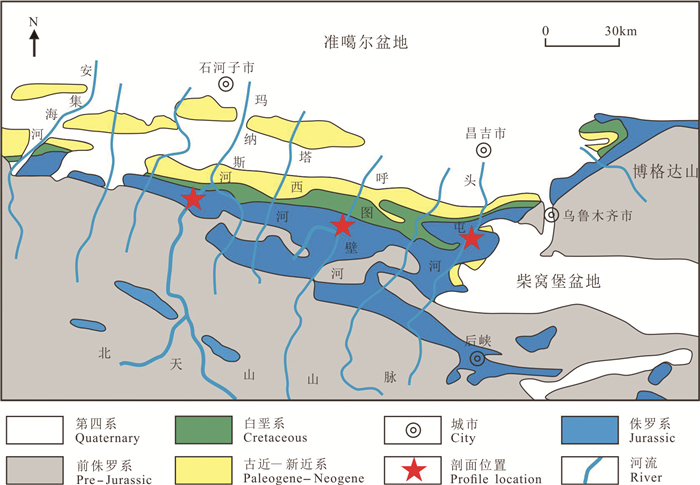
 下载:
下载:
